
Orchid Cactus
- Light: The orchid cactus loves bright light, but do not expose it to direct sunlight.
- Water: Keep the soil moist, except during winter, when you can water sparingly.
- Typical cultivars grow to 2 ft (60 cm) long, and about 2 in (5 cm) wide. Not very showy, but you can count on them to burst into bloom every spring. Flowers emerge at the ends of the stems, and can be 4-8 in (10-20 cm) wide
- Temperature: The orchid cactus will need average room temperatures of 65 to 75 degrees Fahrenheit (18 to 24 degrees Celsius).
- Fertilizer: Feed the orchid cactus high-phosphorus water-soluble fertilizer every two weeks, except in the winter.
Ideal Potting Medium for the Orchid Cactus
In its natural habitat, the orchid cactus grows on tree branches. So, its root system is delicate and needs air to thrive.
And because regular soil is heavy and dense, it could suffocate your plant’s roots.
As such, the best potting mix to use for your orchid cactus is a light, humus-rich, and porous potting soil that drains quickly but holds some moisture.
The soil needs to be coarse and not finely sifted. Moreover, it should also be slightly acidic.
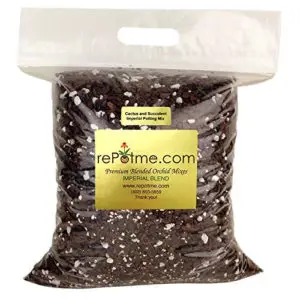
I recommend this wonderful cacti soil mix by repotme. It is easy to use and very well draining.
- High Quality Mix, Handcrafted in small batches
- Blended With Monterey Pine Bark from New Zealand, Red Volcanic Rock, Diatomite, and Premium Grade Pumice.
You can use a regular potting mix with a bit of sand and peat. Sand with salt, like the one you get from the beach, is not recommended.
You also need to make sure that you are using clean sand. You can also mix one part peat moss-based potting mix with one part perlite.
This mixture would allow faster water drainage of water.
For aeration and purification purposes, you can also add generous amounts of charcoal that are crushed into small bits.
Watering the Orchid Cactus

The orchid cactus can be a little fussy when it comes to its water.
It is important to keep the soil moist at all times during its growth period from spring throughout the fall.
You will have to water it sparingly in the winter while also not allowing the soil to dry out completely.
This is because the plant rests in the winter, and it will need just enough water for its stems not to wither.
You will know when you have kept the soil too dry because the stems will go shriveled and limp.
Meanwhile, overwatering the plant will lead the roots and the stems to rot.
If you see the first signs of rotting, immediately cut off the damaged stems.
Other than rotting, too much water can also lead to fungus growth, and it invites gnats and other pests.
You may want to use a soil moisture meter so you could monitor your plant’s water needs.
If the meter says that the soil is dry, you can give your orchid cactus a thorough watering.
It’s also a good idea to mist or spray your plant’s stems, except when it is in bud or is flowering.
Doing this humidifies and cleans the stems of settled dust.
Potting and Repotting
The orchid cactus performs best when it is not over potted, and it is root-bound, which is when its roots fill up its pot and consume all growing space.
This would explain why an orchid cactus in a five-inch (13-centimeter) pot would flower a lot quicker compared to the one that’s planted in a 10-inch (25-centimeter) pot.
It is recommended that you repot your orchid cactus every seven years.
Others also advise that you should do it not more often than every two years when a mature plant calls to be repotted.
You should also transfer your orchid cactus to a pot that is only slightly larger than the current one.
How to Repot the Orchid Cactus

First, take the plant out of the container, clean the soil off its roots, and place it in a larger pot with a drainage hole on the bottom and filled with a fresh batch of well-draining potting mix.
Then wait for about three days to a week before you water the newly repotted orchid cactus.
Do not repot your orchid cactus when it is in bloom because this can cause pot-shock.
Pot shock is what you call the condition when the plant’s root system could not adjust to change, causing its buds and flowers to drop.
You should wait a month after your orchid cactus blooms before you transplant it.
However, people are discouraged from transplanting unless it is truly necessary.
Sun and Lighting Requirement

This plant likes to have bright light, but it does not do well being exposed to direct sunlight, unlike most other cacti.
On the other hand, insufficient light will cause spindly growth and, during flowering seasons, it will have only a few blooms.
Exposure to too much sun will burn the plant’s stems, turning them red.
As such, place your orchid cactus in a location with filtered light.
It is best to place it somewhere where the plant can get full morning sun but does not get exposed to direct sunlight during high noon and in the afternoon.
The Ideal Temperature and Humidity Levels
The orchid cactus needs moderate indoor humidity levels of about 40 percent to 50 percent.
For extra dry homes, you can raise the humidity in the room by using a cool-mist humidifier.
But if you just need to boost humidity a little bit for your plant, you can place a dish of wet pebbles underneath its pot.
During the winter, our homes tend to be very dry.
You can spray your orchid cactus with a mist of water in case the humidity level dips too low.
Remember that very depleted conditions can contribute to problems that pertain to the roots, especially if the soil is not well-drained.
Additionally, without adequate levels of humidity, the plant’s buds may drop.
In terms of the ideal temperatures for the orchid cactus, the average room temperature of 65° to 75°F (18° to 24°C) is good.
However, if you want to promote flowering, give the plant eight to 10 weeks of cold days of 60° to 65°F (16°to 18°C) days and 45° to 55°F (7° to 13°C) nights during winter.
Making the Orchid Cactus Bloom
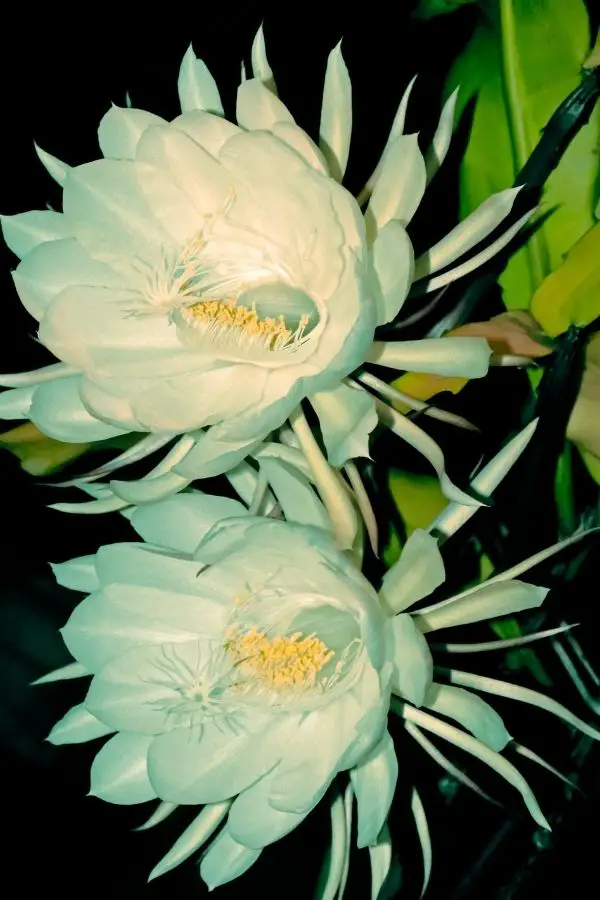
Orchid cacti are early bloomers. This means that they flower even while they are still young.
They flower starting February, and some would still keep flowering well into July.
You can do a few things to help your orchid cactus bloom.
- Allow the plant to rest in the winter. Your plant will need a cool, dry winter rest for about eight to 10 weeks so it can set buds. During this period, you’ll need to water it sparingly, as well as stop fertilizing it.
- Give the plant correct lighting. It is important to give your orchid cactus bright, indirect light all year round. And in case you decide to move the plant outdoors for the summer, make sure to keep it shaded from direct sunlight.
- Feed and fertilize it. A fertilizer that is high in phosphorus will encourage more blooms during the plant’s flowering season. You can feed or apply fertilizer starting early spring until the fall. After the feeding cycle, leave the plant alone and let it rest for the winter.
As soon as buds appear, keep the plant in the same location.
Moving it around during this time would mean changes in temperature and lighting, and these changes will cause the plant to drop its buds and flowers.
Remember to keep your orchid cactus away from drafty areas of your home, like heat/AC vents and doorways.
Feeding Orchid Cacti
You can fertilize your orchid cactus with a water-soluble 10-10-10 fertilizer once each month from spring through autumn during the growing season.
Use about one teaspoon of fertilizer and dilute it with one gallon of water.
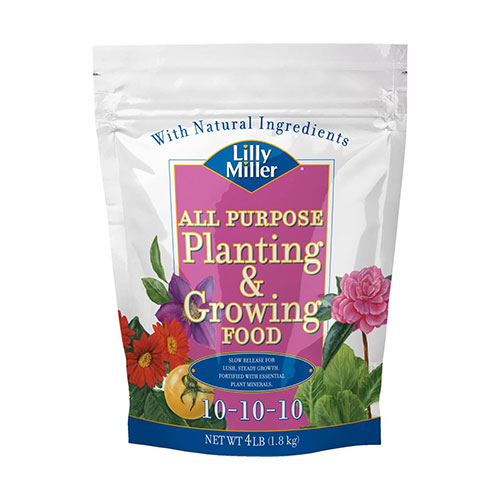
We recommend this fertilizer, made with natural ingredients. Make sure to follow the instructions and not use too much fertilizer.
- 10-10-10 4Lb All Purpose Fertilizer With Slow Release For Lush, Steady Growth
- Concentrated, Fast-Acting Ingredients
- This Product Is Made In United States
Remember to avoid fertilizers that contain more than 10 percent nitrogen.
Instead, go for a phosphorus-rich one. Use a diluted fertilizer of 10-10-10 during the growth periods in spring and fall. You can then switch to a ratio of 2-10-10 in February to promote root development and flowering.
As soon as buds start to appear, you can suspend feeding until October.
Growing and Propagating an Orchid Cactus
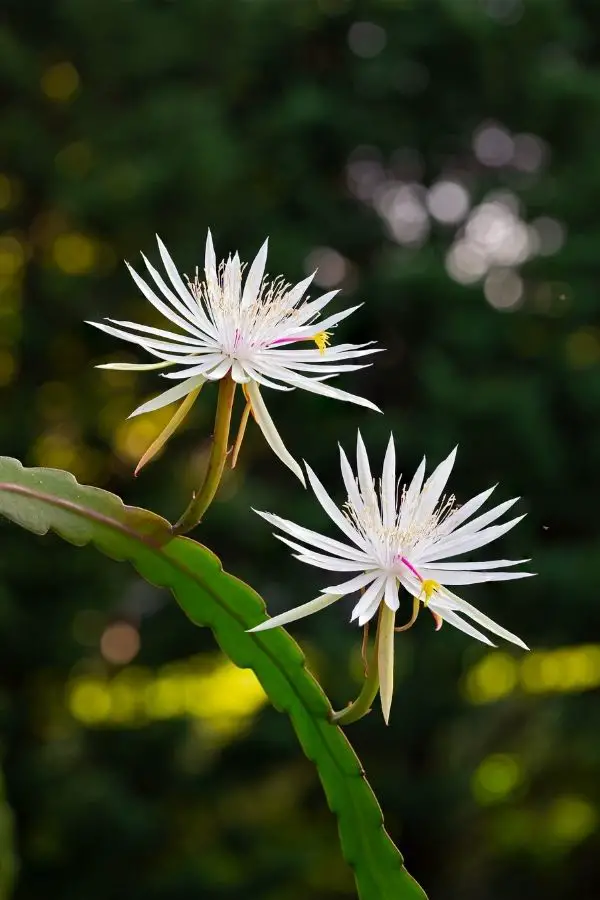
An orchid cactus is grown from seed.
However, a much quicker and more common method for propagating a plant is through stem cutting.
- You can detach stem sections that are four to six inches (10 to 15 centimeters) in length. It is best to take cuttings in the spring or the summer.
- Be sure to make a clean cut on new growth. Leave the cuttings for several days to form a callus on the cut end.
- Plant the callused end of your cutting one-inch deep into a clean, moderately moist potting soil.
- Place your pot of newly planted orchid cactus stem at room temperature, which is 65 to 75 degrees Fahrenheit (18 to 24 degrees Celsius), in a bright area with indirect sunlight. Be sure to keep the soil misted all the time.
- Wait for three to six weeks for your new cutting to root.
Remember to handle the orchid cactus cuttings with care.
Check out the stems for bruises or broken spots. New roots can also give the fungus a way to enter.
Common Orchid Cactus Problems
Growing an orchid cactus is relatively easy, but this does not guarantee a 100-percent success rate for everyone.
Even if you plant it in the right kind of soil, give it the right amount of watering, and feed it the right kind of fertilizers, you could still encounter problems with your orchid cactus.
So what are the most common problems associated with growing an orchid cactus?
Pesky Pests
Regardless of the amount of care you give your plants, they can still be infested by bugs and pests.
These insects are relentless, and if you don’t do anything to get rid of them immediately, they could end up killing your plant.
The most common of these pests are mealybugs and scale insects. Scales are tiny, flat, reddish-brown insects that stick to plants and suck their juices, leaving a sticky substance on the leaves.
Mature scales have a hard, round shell, which makes them quite difficult to kill.
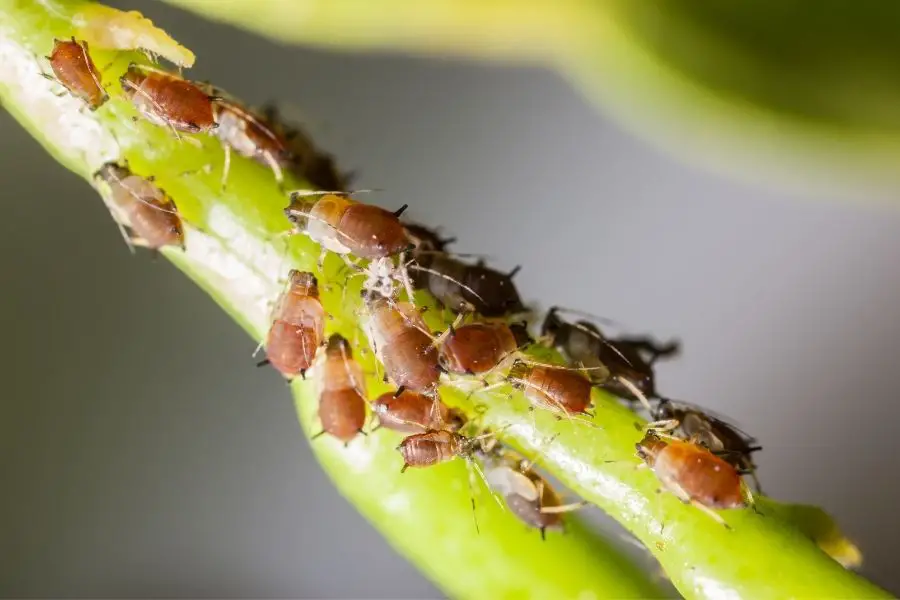
You can get rid of young scale insects by spraying soapy water.
For this, you can use two teaspoonfuls of mild and fragrance-free dishwashing liquid diluted in one gallon of lukewarm water.
Spray once a week until the insects are gone.
Make sure to rinse the soapy solution off with room-temperature water.
You can also dab the scales with cotton soaked in rubbing alcohol.
Just be careful applying this because alcohol can damage plant tissue.
On the other hand, Mealybugs are small white insects with a waxy and fluffy white coating that makes them look like cotton specks.
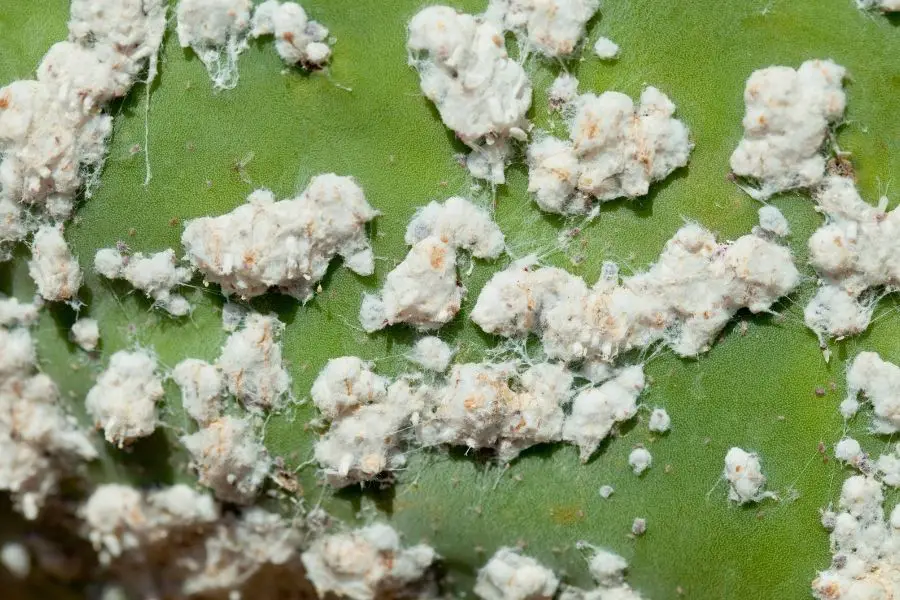
These insects form colonies, feed on plant juices, damage plant tissue, and secrete a sort of honeydew that attracts ants and sooty mold.
Stems are one of their favorite feeding spots, and cacti are among their favorite house plants.
You can get rid of mealybugs by removing them by hand. You can also dip a cotton swab in rubbing alcohol and then use it to wipe off all the bugs.
You can also try a systemic insecticide placed in the soil and put a toxin into the plant system to poison the mealybugs when they feed on the plant.

We recommend this affordable, yet very efficient natural pesticide.
Made with natural ingredients, it works very well to get rid of common pests on your cacti.
- Ready to use, no mixing required
- Made with high quality essential oils and natural ingredients
- Very efficient
Fungi and gnats may also pose a problem if your soil is kept too wet.
If slugs or snails can get to these plants while you have them outdoors in the summer, they can do a lot of damage.
According to Orchideria, the number one pest that bothers the orchid cactus the most are snails.
These crawling creatures are attracted to the plant’s moisture near the base.
These snails will climb up the stems and munch on them and the plant’s tasty buds. If snails are not dealt with properly, they would also attract other insects, like ants.
This is one reason why opting for a hanging basket is the perfect solution for an orchid cactus.
Wind
The wind is considered the biggest problem for an orchid cactus.
Strong, harsh wind currents could rip the stems in half, break them off, or bend them out of shape so that they leave ugly markings.
Therefore, when you take your plant outside in the spring and summer, you have to make sure you place it or hang it up in a safe spot from wind currents.
Dropping Flower Buds
It is important not to move the plant around the moment its buds set.
The orchid cactus is rather sensitive about changes in certain factors, including light, temperature, and humidity, so if it feels there’s the slightest change in any of these things, its flower buds may start to fall off.
Limp Stems
The stems of the orchid cactus can turn limp and blackish at its base.
This indicates stem rot, and it is caused by overwatering. Cut off all the stems that are rotting at the soil level.
More importantly, allow the soil to dry and lessen your watering to keep more stems from rotting.
Frequently Asked Questions
Here are some other frequently asked questions about orchid cactus.
What is an Orchid Cactus?
The orchid cactus was named as such because of its growth habit and its large flower.
This plant is an epiphyte, which means that it grows on and hangs from other plants, just as an orchid does.
However, while this cactus originally grows on trees, it is not parasitic; it merely uses the tree or the bigger plant as host and physical support.
This cactus is native to Central and South America and has around 20 species. It has stems that are strung together by a woody middle vein, and these stems grow anywhere from 18 to 30 inches (46 to 76 centimeters) long and about two inches (five centimeters) wide. This plant does not have thorns and is not showy, but it constantly blooms in the spring.
While it originated from tropical forests, it does produce blooms the best when exposed to shortened light periods and cool temperatures. The flowers appear at the end of its stems, and they can be up eight inches (20 centimeters) wide. Orchid cactus flowers can come in red, pink, yellow, white, purple, orange, or even bicolored. With a lot of sunlight, this cactus will continue to burst with flowers for months, but each flower lasts only a couple of days.
Moreover, this cactus bears fruits that you can actually eat. Many compare the taste of its fruit as similar to that of the passion vine fruit, but its texture and its small black seeds are more like a kiwi’s.
What Kind of Pot Is the Best to Use for an Orchid Cactus?
Since orchid cacti grow off the ground in their natural habitat and have flat stems that dangle several inches down, the best type of pot to use is a hanging basket.
You can also use different pots, but it is still ideal for placing it somewhere elevated, such as on the high shelf.
How Often Do Orchid Cacti Bloom?
There are orchid cacti that bloom during the day, and there are also those that bloom at night.
The daylight bloomers typically flower from late winter through early summer, while the night bloomers flower from late summer until early fall.
When Do I Need to Repot My Orchid Cactus?
An orchid cactus usually does well in its pot for two to three years at a time.
This plant prefers to be pot-bound, and it likes to feel cramped in its container, so frequent repotting is not required.
Most of the time, you just need to top-dress it by adding a layer of your potting mix to your current pot.
Moreover, when you repot, get a pot that is only one size larger.
You also need to keep in mind that an orchid cactus that is in bloom should not be repotted, even if it looks like it’s already bursting from its container.
What Is the Ideal Watering Schedule for an Orchid Cactus?
The name cactus could be confusing for many beginners.
They might think the plant doesn’t like to be watered a lot and that one should wait for the soil to go completely dry before watering.
But this is not the case because the orchid cactus is not your typical cactus.
Orchid cacti don’t like to dry out. At the same time, it also does not want to be watered. So it is a balancing act between letting the plant dry out or overwatering them.
With that being said, Times Herald-Record recommends that you water your orchid cactus weekly but that you should allow the top two to three inches of soil to dry out completely before you re-water.
You will also have to adjust your watering schedule in case the soil takes a little longer to dry out. Just remember that the goal is to keep your plant’s roots moist yet not saturated.
What Is a Dormancy Period in Orchid Cactus?
Dormancy is the state of a plant when it shows no growth at all or just very little of it.
It ceases or reduces any metabolic activity for a period of time.
What brings the dormancy period?
Well, most plant life functions best when temperatures are above freezing point throughout the year.
However, plants that are in moist, tropical regions are exposed to dry periods, as well as temperatures that are below freezing at one point during the year.
Also, unlike animals, plants don’t enjoy the benefits of locomotion or body insulation.
They cannot seek shelter or do other activities to survive the cold weather and water shortages.
Consequently, many plants have no choice but to become dormant so they could avoid unpleasant environmental conditions.
During a dormancy period, you wouldn’t have to water your plant at all.
An orchid cactus goes into dormancy for eight to 10 weeks. After it has bloomed and all its flowers have fallen off, its cactus will temporarily “shut down” so it could recuperate and store energy.
It will need to save up energy for when it resumes and starts a new growth period. Moving your plant to a dark, cooler place during the dormant period will respond better.
What Color Are the Orchid Cactus’ Flowers?
There are different varieties of orchid cactus that give a variety of colors.
Most of the ones grown in homes today are hybrids, and they come in gorgeous red, pink, orange, yellow, purple, white, and even bicolored ones.
Can You Prune an Orchid Cactus?
You can prune an orchid cactus.
It will be a good time to repot the orchid cactus when all its flowers have fallen off.
However, before repotting, you should trim off any dead and yellowing stems. And before you actually begin cutting, you have to make sure that you have sterilized the shears with alcohol, flame, or a bleach solution.
This is a safe way to keep the plant from spreading infections and from hosting microorganisms that could eventually kill it.
Final Thoughts
An orchid cactus is easy to grow, propagate, and care for. It has different requirements from other cacti and succulents, but it is low-maintenance in its unique way. For one, it doesn’t need frequent repotting, and as long as you make sure its soil is moist and doesn’t go too dry, you can pretty much leave it alone.
You will need to plant your orchid cactus in an airy and well-draining potting mix, give it the appropriate kind of nutrition, make sure that it is safe from pests and direct sunlight, allow its dormant period, and give it the amount of water, light, and humidity it needs. Your orchid cactus will thrive. And it more than makes up for all these things by giving you big and brilliant blooms that will brighten your room.
Sources
- Gardening Know How: Epiphyllum Plant Care: Tips for Growing Epiphyllum Cactus
- Plant Care Today: Epiphyllum Orchid Cactus: Growing Tips And Care
- Orchid Resource Center: The Orchid Cactus: Your Most Common Questions Answered
- World of Succulents: How to Grow and Care for a Red Orchid Cactus
- Guide to Houseplants: Scale Insects: How to Identify and Get Rid of These Houseplant Pests
- Guide to Houseplants: Mealybugs: How to Identify and Get Rid of These Houseplant Insects
- Orchideria: Orchid Cactus: Complete Guide to Care and Propagation
- Record Online: Properly Caring for the Orchid Cactus
- Life of Plant: Dormancy
I have a Orchid Cactus that is about 3 feet tall with alot of long branches on it. I live in Ohio so it spends the winter in my house. I have had it for about 5 years and it only got one flower that fell off right away. What am I doing wrong how do I get it to flower?
We live in Northeastern Ohio. We inherited an Orchid Cactus from my mother. It never flowered the 10 years that she had it. Instead, it grew long gangly stems that circled her bedroom ceiling. It had very few leaves. After she passed and the plant ended up at our house, I couldn’t bear the thought of discarding it. I transplanted it and cut it down to within inches from the soil. After another ten years passed, at our house in Ohio, we finely did the right things to make it blossom. Of course, it was completely by accident. It was then that I did research to discover the name of the plant and how to care for it. We have a sunroom where we keep all our plants over the winter. In spring, we move everything outside. The cactus usually got put on the back deck were it received direct morning sun. It never produced flowers there. One year, we moved it to another location where it received indirect lighting all day with a short time of direct light in the evenings. That’s all it took. We get blossoms regularly now.